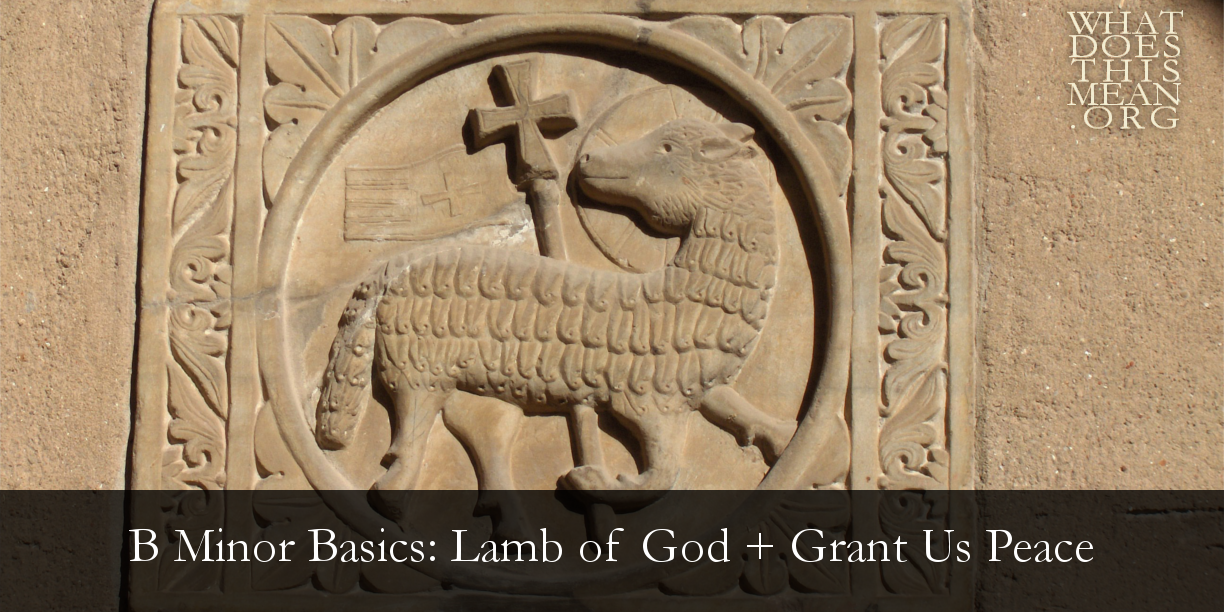But it is Bach, making music in the Castle of Heaven, who gives us the voice of God—in human form.
| Sanctus – six-part chorus with full orchestra Hosanna – double chorus with full orchestra Benedictus – tenor aria with chamber orchestra Hosanna – double chorus with full orchestra Agnus Dei – alto aria with limited orchestra Dona Nobis Pacem – four-part chorus with orchestra |
| Lamb of God, pure and holy, Who on the cross didst suffer, Ever patient and lowly, Thyself to scorn didst offer. All sins Thou borest for us, Else had despair reigned o’er us: Have mercy on us, O Jesus! O Jesus! (Lutheran Service Book 434.1) |
| Agnus Dei, qui tollis peccata mundi, miserere nobis. | Lamb of God, who takes away the sins of the world, have mercy on us. |
| If one brings to mind the similar fermatas in the arias of the St. John and St. Matthew Passions, it will be found that the meaning of the fermatas is the same despite the diversity of the movements: when contemplating the suffering, crucifixion, and death of Jesus, the music pauses to permit time for humble reflection upon the meaning of this suffering (Bach’s Mass In B Minor, p. 147). |
| Dona nobis pacem, pacem dona nobis. |
For the music of the Dona Nobis Pacem, Bach followed his established pattern of contrasting smaller arias with larger choruses. The full orchestra now enters, doubling the parts of the four-part chorus. In the following video, listen for the initial entry in the lower voices, followed by a gradual ascension to the heights of heaven. As you listen to the following performance by the Bach Collegium Japan, ask yourself if you recognize the music from an earlier movement of the B Minor:
| Dona nobis pacem. | Grant us peace. |
| Gratias agimus tibi propter magnam gloriam tuam. | We thank You for Your great glory. |
We have now reached the end of our survey of the entire B Minor Mass, and yet our journey has only begun. Once more from John Eliot Gardiner: “We are [Bach’s] successors and the beneficiaries of his vision. Every time we perform it marks just the latest point in the work’s continuing and continuous unfolding” (BACH, p. 522). One of my favorite episodes in this continual unfolding of the legacy of the B Minor comes from the work of the late choral conductor, Robert Shaw (1916-1999). In 1962, Mr. Shaw took his famous Robert Shaw Chorale behind the Iron Curtain for a tour of Russia. The Chorale visited 11 cities and gave 30 concerts over a period of six weeks, all done at the height of the Cuban Missile Crisis and tensions between the U. S. and the Soviet Union. Mr. Shaw prepared three programs for this tour. But big “hit” was the B Minor Mass. Audiences would remain in the halls after the concerts, often for up to an hour, and often on their feet. Soviet Radio broadcast one concert in its entirety, including 10 minutes of applause at the end of the concert. In Leningrad, several hundred people stood in line all night to get coupons from a government bureau that would entitle them to stand in line again the following day to get actual tickets. In the city of Lvov, a riot broke out when several hundred people, unable to get tickets, knocked down the door and pushed their way in to an already full concert hall to hear the B Minor.
What could possibly explain this reaction of the Soviet people to a performance of Western music by an American choir and orchestra? Mr. Shaw liked to tell the story of the group’s tour guide, an old man named Petrov. In his last conversation with Petrov on the way to the Moscow airport, Mr. Shaw asked Petrov why the Russian response to the B Minor was so tumultuous. Petrov’s reply (pardon the mistranslation of the Kyrie in this quote) summarizes the legacy of the B Minor that has led the present writer on a decades-long journey to fathom the continuous unfolding of its depth—and I am just getting started!
| I was with you in every audience, you know. And it never failed; within three minutes after you had begun to sing, people forgot that you were Americans or performers, and that they were in a concert hall. They were simply hearing, Kyrie eleison, “Lord our God have mercy,” or Dona nobis pacem, “Give us peace.” It was like one heart talking to another heart—or more like Bach’s heart talking to all of us (Keith Burris, Deep River: The Life and Music of Robert Shaw, pp. 122-123). |



 RSS Feed
RSS Feed
